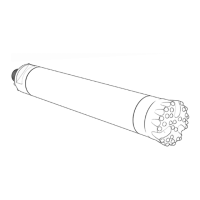8
Safety: Operation
• When drilling on soft or unstable ground, great care must
be taken because the flushing air from the hammer can erode
the material around the drill hole, and so undermine the
ground beneath the drill rig. This can pose a great danger to
personnel and risk damaging the equipment.
• Keep your hands and clothing well clear of the hammer
and drill string when it is rotated. Entanglement can result in
serious injury.
DANGER
• Take great care when jointing drill pipes. Make sure there
is no danger of your fingers being pinched or clothing being
entangled when the drill string is rotated.
• When a pipe wrench is used during jointing, there is a risk
of the wrench fiying off and causing injury when rotation is
applied.
• Always wear safety glasses during drilling!
• Keep your clothing, hair etc. well clear of rotating compo-
nents! Careless ness can result in serious injury.
• The exhaust air from the hammer (and also from the back-
head if a unit for extra flushing is fitted) has a very high velo-
city. Objects such as small stones, drill cuttings, sand, earth
and oil residue that are transported in the flushing air can
cause serious injury to unprotected eyes. Pay special attention
to this danger during collaring, when a jetsub or hydrocyclon
are in use, and when the hammer is fed through the drill steel
support or down into the hole.
WARNING
• Always wear ear protectors during drilling.
• The injection point for water and foaming concentrate should
always be located after the main shut-off valve on the rig.
If not, there is a danger of the mixture being pumped back
through the main air line and into the compressor. This could
seriously damage the compressor.
CAUTION
the drill string is lifted from the hole. If the hammer is going to
be stored for a long time, it should be dismantled and all parts
cleaned and oiled thoroughly.
If you would like to know more about flushing media or have any
questions regarding foaming concentrates not supplied by Epiroc,
please consult your nearest Epiroc representative for advice.
How to collar the hole
5 cm
1) Feed the hammer down-
ward until the drill bit is
about 5 cm from the
collar ing point.
2) Start rotation to the
right at low speed (crep
ing).
3) Feed the hammer on
to the rock using minimal
feed force, so that the bit
is pressed into the ham
-
mer, and into the impact
position.
4) Start collaring the hole
with reduced impact and feed, until the bit has entered the rock.
5) Open the impact mechanism control fully and adjust the rota
-
tion and feed so that the hammer drills smoothly and steadily.
Always rotate to the right!
DTH hammers must always be
rotated to the RIGHT during drilling
(clock wise), even when the hammer
is not operating� Rotation to the
right should be switched on as long
as other operations are in progress
with the hammer in the hole.
When breaking the joints between
drill pipes, bear in mind that the drill
string must not be rotated anti -
clockwise any more than is abso
-
lutely necessary.
Left-hand rotation (or no rotation)
will cause the driver chuck to loosen,
which could mean losing the drill bit
(or even the entire hammer) down
the hole. Inadequate feed pressure
can loosen threaded joints to back
-
head, chuck and pin connection.
Remember:
• Always switch on rotation to the right before starting the feed or
hammer.
• Let the hammer rotate to the right (clockwise) even during
lifting or lowering of the hammer.
Do not switch off rotation to the right until all other functions have
been switched off.

